Insulanoplectron is a genus of cave wētā in the family Rhaphidophoridae, with just one species: the Snares Island Wētā. Insulanoplectron spinosum is endemic to the subantartic Snares Island of New Zealand, where it is considered to be naturally uncommon. Wētā are nocturnal crickets found all around the world. During the day on the Snares, wētā can be found hiding in seabird burrows.

Sigaus homerensis is a grasshopper endemic to the southern South Island of New Zealand. It is known only from three isolated populations in Fiordland.

Sigaus childi is an endangered protected species of grasshopper known only from the Alexandra district of the South Island of New Zealand. It is one of just two species of grasshopper listed for protection under the New Zealand Wildlife Act 1953. It is currently classified as "At Risk, Naturally Uncommon" by the Department of Conservation. The genus Sigaus is endemic to New Zealand.

Sigaus robustus is a New Zealand species of grasshopper classified as Threatened: Nationally Endangered. It is restricted to open stony habitat of the Mackenzie Basin of the South Island. Although a grasshopper, it is a poor jumper, relying on camouflage to hide from predators. It is threatened by introduced mammals such as stoats, hedgehogs, and rats.
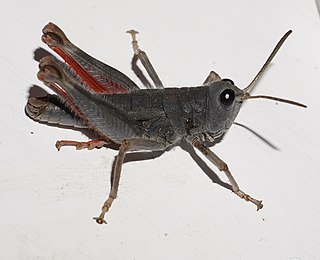
Sigaus villosus is New Zealand's largest grasshopper. It is only found in the central mountains of the South Island. The genus Sigaus is endemic to the New Zealand. Like all of New Zealand sub-alpine and alpine grasshoppers S. villosus has a 2 or 3 years life cycle. The eggs must ‘overwinter’ before they will hatch. Hoppers are found throughout the year and adult grasshoppers can be found throughout the New Zealand summer between December and April. Adult S. villosus do not overwinter.

Sigaus tumidicauda is a species of alpine grasshopper, endemic to New Zealand. Like all of New Zealand sub-alpine and alpine grasshoppers, S. tumidicauda has a 2- or 3-year life cycle. The eggs must "overwinter" before they will hatch. Hoppers are found throughout the year, and adult grasshoppers can be found throughout the New Zealand summer between December and April. This grasshopper is flightless.

Sigaus is a genus of grasshoppers in the tribe Catantopini that is endemic to New Zealand. All but one Sigaus species is endemic to the South Island: Sigaus piliferus is the only North Island representative and is the type species. Most species in this genus are restricted to alpine habitats. All are wingless and make no sounds.

Sigaus australis is the most common alpine grasshopper found in New Zealand. It can be found in the southern half of the South Island above the tree line. Sigaus australis was described in 1897 by Frederick Hutton. Like all of New Zealand sub-alpine and alpine grasshoppers S. australis has a 2 or 3 years life cycle. Individuals can survive the cold by freezing solid at any life stage, at any time of the year. Sigaus australis adults are relatively large grasshoppers. The genus Sigaus is endemic to New Zealand.

Sigaus crassicauda is a species of alpine grasshopper endemic to New Zealand. Like all of New Zealand sub-alpine and alpine grasshoppers S. crassicauda has a 2 or 3 years life cycle. The eggs must ‘overwinter’ before they will hatch. Grasshoppers are found throughout the year and adult grasshoppers can be found throughout the New Zealand summer between December and April. Sigaus crassicauda cannot fly.

Phaulacridium marginale is a small species of short-horned grasshopper in the family Acrididae. It is endemic to New Zealand where it is found in low elevation open habitat throughout North Island, South Island, Stewart Island and on many smaller islands.

Phaulacridium otagoense is an endemic New Zealand grasshopper found at low elevation throughout the central South Island.
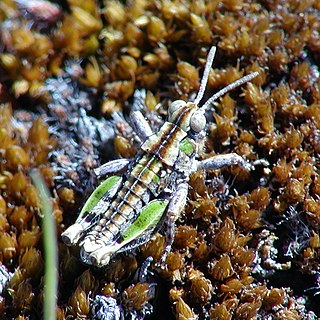
Sigaus minutus is a species of short-horned grasshopper in the family Acrididae. It is one of the smallest and rarest species of grasshopper in New Zealand, found only in the Mackenzie district of South Island. There are 13 species within the genus Sigaus described by Bigelow (1967), all endemic to New Zealand. The population status of Sigaus minutus is declining according to threat assessments made by orthopteran experts in 2010.
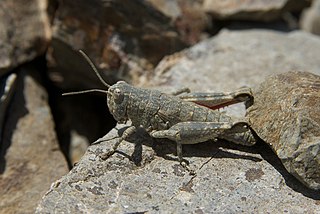
Sigaus nivalis, is an alpine short-horned grasshopper, endemic to the South Island of New Zealand. Sigaus nivalis is brachypterous and flightless, therefore they travel by hopping. They bask during the day so need open habitat.

Wētā is the common name for a group of about 100 insect species in the families Anostostomatidae and Rhaphidophoridae endemic to New Zealand. They are giant flightless crickets, and some are among the heaviest insects in the world. Generally nocturnal, most small species are carnivores and scavengers while the larger species are herbivorous. Although some endemic birds likely prey on them, wētā are disproportionately preyed upon by introduced mammals, and some species are now critically endangered.
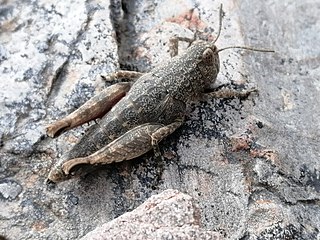
Brachaspis is a genus of grasshoppers belonging to the family Acrididae.
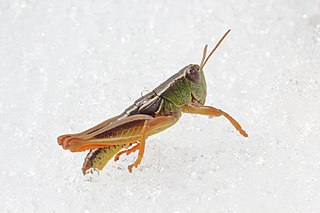
Paprides is a genus of short-horned grasshoppers in the family Acrididae. There are at least two described species in Paprides, found in New Zealand. Both species were moved to the genus Sigaus in 2023

Tasmaniacris is a genus of short-horned grasshoppers in the family Acrididae. There is one described species in Tasmaniacris, T. tasmaniensis, found in Tasmania. This grasshopper is flightless (micropterous). T. tasmaniensis is sister to the Tasmanian Russalpia species.
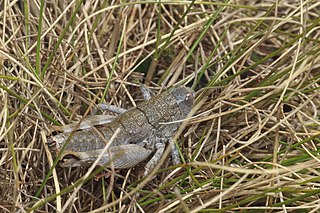
The Green Rock-hopper grasshopper, Sigaus collinus is an alpine species of short-horned grasshopper in the family Acrididae. It is found in New Zealand in the mountains of northern South Island, above the tree line and as high as 2000 m asl. In New Zealand alpine grasshoppers can freeze solid at any time of the year and are alive when they thaw out when temperatures rise.

Sigaus piliferus is a species of short-horned grasshopper in the family Acrididae. It is found in New Zealand. Sigaus piliferus is restricted to alpine and sub-alpine habitats in North Island New Zealand. This grasshopper species has two ecotypes - the shubland form in the north with relatively long legs and the alpine form in the south. The two ecotypes were probably isolated during the last glacial maximum but are now in contact in the central volcanic region of North Island.




















